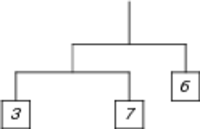Problem A - Equilibrium Mobile
Time limit: 2 seconds
 A mobile is a type of kinetic sculpture constructed to take advantage
of the principle of equilibrium. It consists of a number of rods, from
which weighted objects or further rods hang. The objects hanging from
the rods balance each other, so that the rods remain more or less
horizontal. Each rod hangs from only one string, which gives it
freedom to rotate about the string.
A mobile is a type of kinetic sculpture constructed to take advantage
of the principle of equilibrium. It consists of a number of rods, from
which weighted objects or further rods hang. The objects hanging from
the rods balance each other, so that the rods remain more or less
horizontal. Each rod hangs from only one string, which gives it
freedom to rotate about the string.
We consider mobiles where each rod is attached to its string exactly
in the middle, as in the figure underneath. You are given such a configuration,
but the weights on the ends are chosen incorrectly, so that the
mobile is not in equilibrium. Since that's not aesthetically pleasing,
you decide to change some of the weights.

What is the minimum number of weights that you must change in order to
bring the mobile to equilibrium? You may substitute any weight by any
(possibly non-integer) weight. For the mobile shown in the figure,
equilibrium can be reached by changing the middle weight from 7 to
3, so only 1 weight needs to changed.
Input
On the first line one positive number: the number of testcases, at
most 100. After that per testcase:
Output
Per testcase:
-
One line with the minimum number of weights that have to be changed.
Sample Input
3
[[3,7],6]
40
[[2,3],[4,5]]
The 2008 ACM Northwestern European Programming Contest
 A mobile is a type of kinetic sculpture constructed to take advantage
of the principle of equilibrium. It consists of a number of rods, from
which weighted objects or further rods hang. The objects hanging from
the rods balance each other, so that the rods remain more or less
horizontal. Each rod hangs from only one string, which gives it
freedom to rotate about the string.
A mobile is a type of kinetic sculpture constructed to take advantage
of the principle of equilibrium. It consists of a number of rods, from
which weighted objects or further rods hang. The objects hanging from
the rods balance each other, so that the rods remain more or less
horizontal. Each rod hangs from only one string, which gives it
freedom to rotate about the string.
